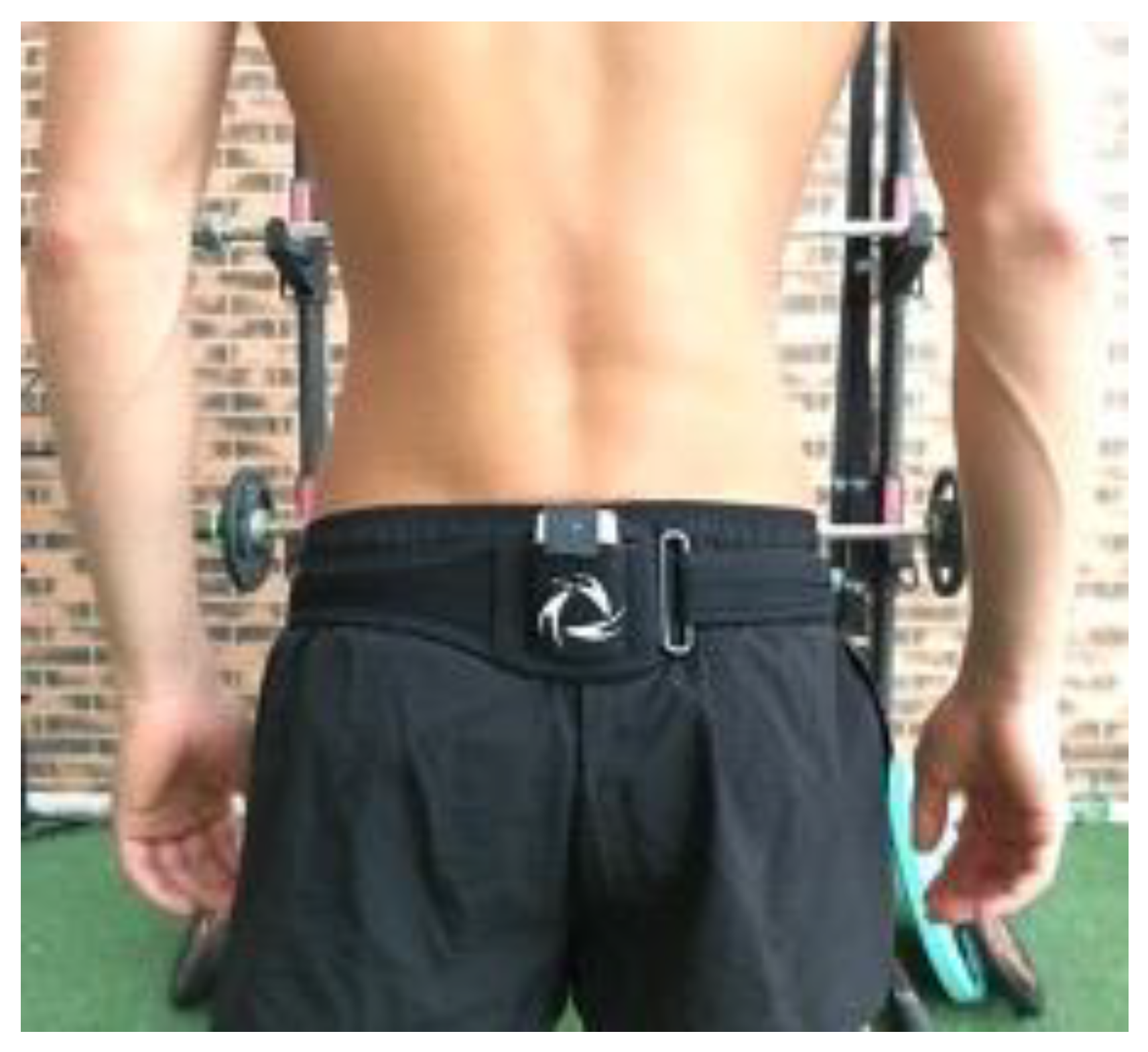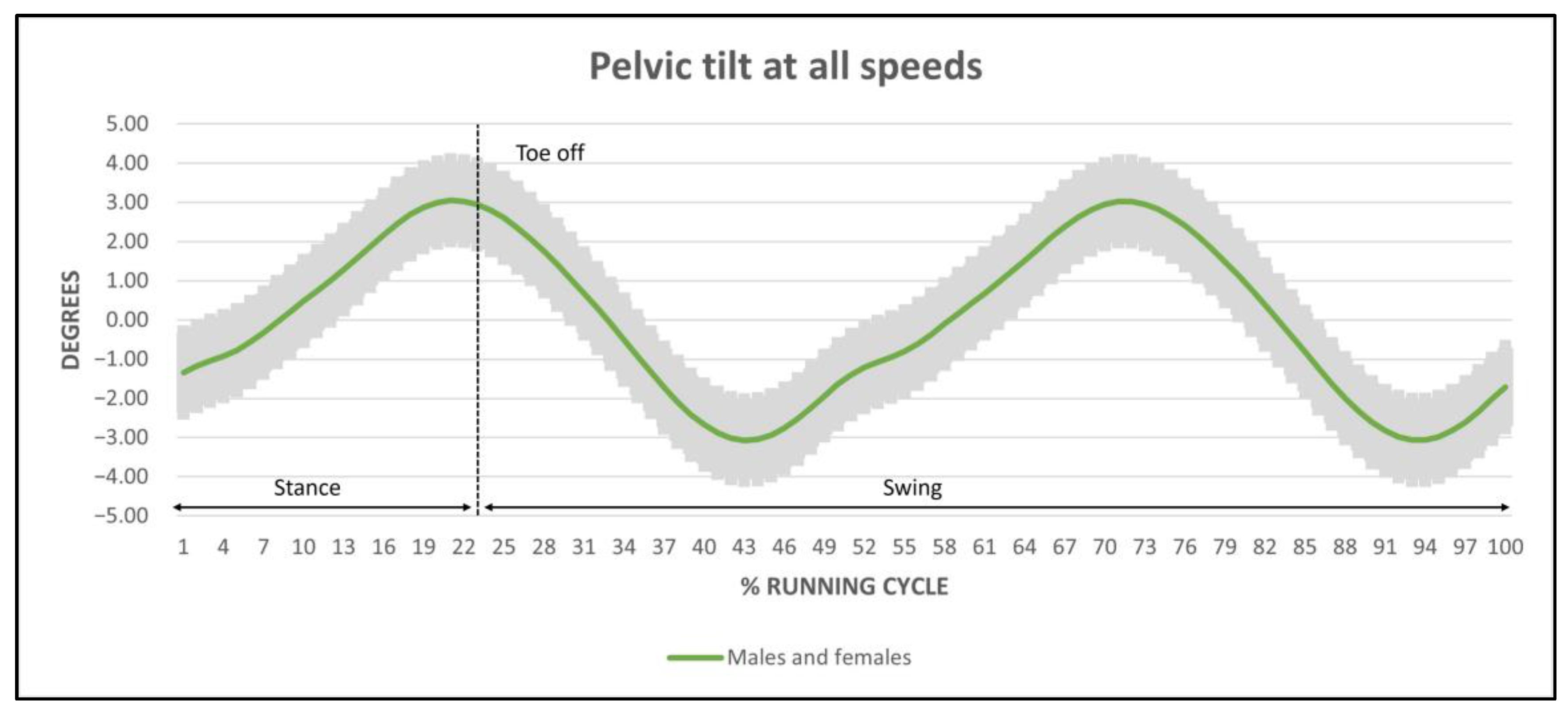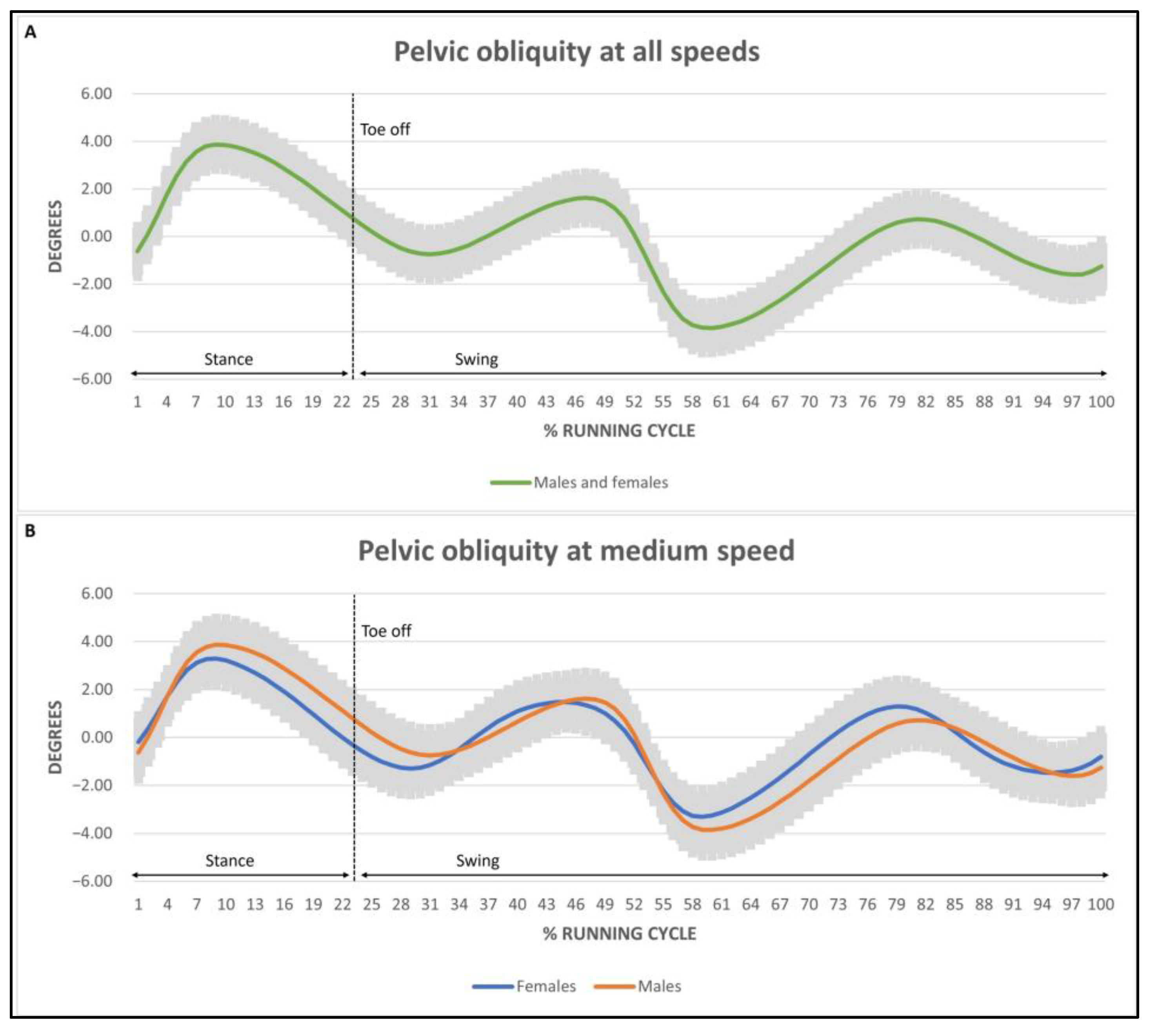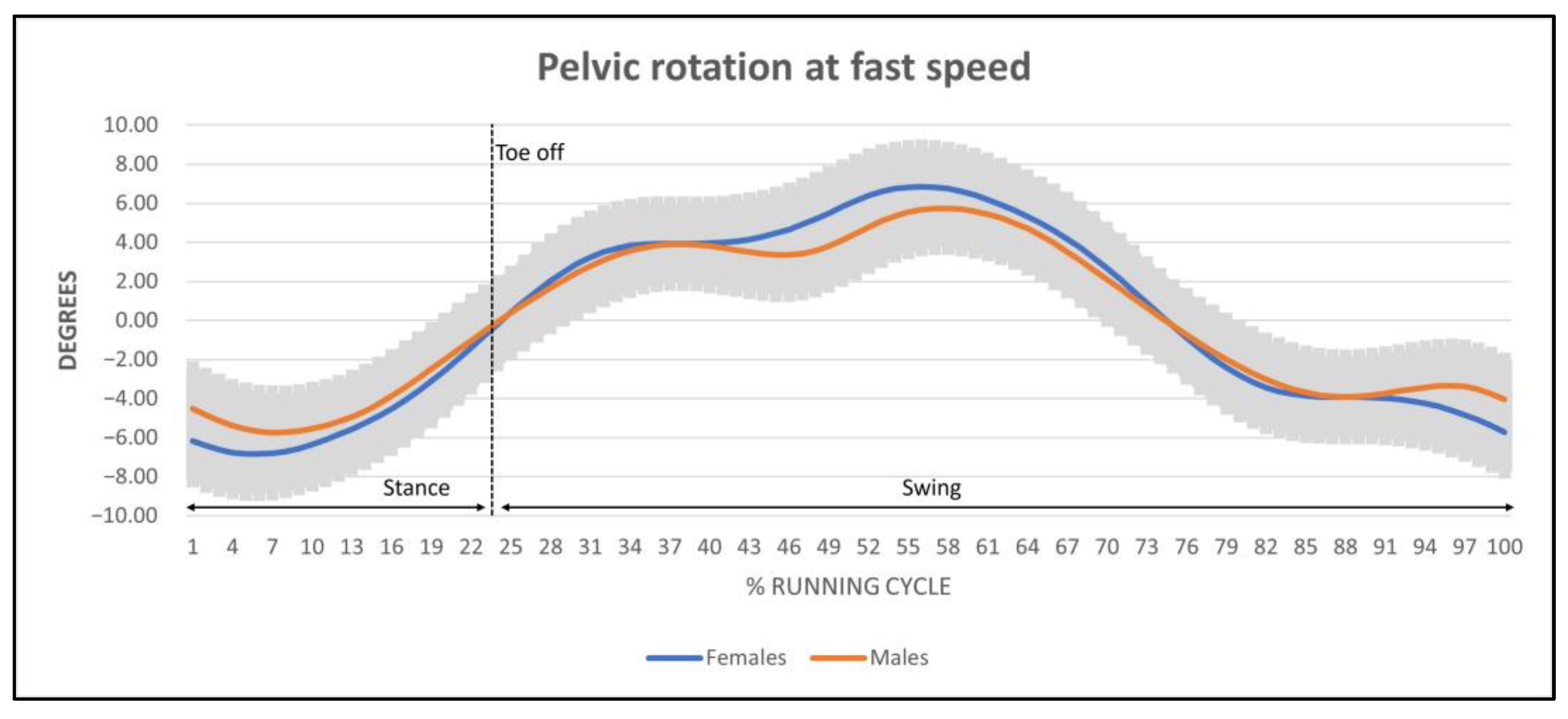Differences between Sexes and Speed Levels in Pelvic 3D Kinematic Patterns during Running Using an Inertial Measurement Unit (IMU)
Abstract
1. Introduction
2. Materials and Methods
2.1. Participant Charateristics
2.2. Procedure
2.3. Statistical Analysis
3. Results
3.1. Normative Values of the Pelvic Kinematics and Spatiotemporal Outcomes
3.2. Reliability of the IMU Sensor during Running
4. Discussion
5. Conclusions
Author Contributions
Funding
Institutional Review Board Statement
Informed Consent Statement
Data Availability Statement
Conflicts of Interest
References
- Van Poppel, D.; van der Worp, M.; Slabbekoorn, A.; van den Heuvel, S.S.P.; van Middelkoop, M.; Koes, B.W.; Verhagen, A.P.; Scholten-Peeters, G.G.M. Risk Factors for Overuse Injuries in Short- and Long-Distance Running: A Systematic Review. J. Sport Health Sci. 2021, 10, 14–28. [Google Scholar] [CrossRef] [PubMed]
- Vitti, A.; Nikolaidis, P.T.; Villiger, E.; Onywera, V.; Knechtle, B. The “New York City Marathon”: Participation and Performance Trends of 1.2M Runners during Half-Century. Res. Sport. Med. 2020, 28, 121–137. [Google Scholar] [CrossRef] [PubMed]
- Nielsen, R.O.; Buist, I.; Parner, E.T.; Nohr, E.A.; Sørensen, H.; Lind, M.; Rasmussen, S. Predictors of Running-Related Injuries Among 930 Novice Runners: A 1-Year Prospective Follow-up Study. Orthop. J. Sport. Med. 2013, 1, 232596711348731. [Google Scholar] [CrossRef]
- Hreljac, A. Impact and Overuse Injuries in Runners. Med. Sci. Sport. Exerc. 2004, 36, 845–849. [Google Scholar] [CrossRef] [PubMed]
- Van Gent, R.N.; Siem, D.; van Middelkoop, M.; van Os, A.G.; Bierma-Zeinstra, S.M.A.; Koes, B.W. Incidence and Determinants of Lower Extremity Running Injuries in Long Distance Runners: A Systematic Review. Br. J. Sport. Med. 2007, 41, 469–480; discussion 480. [Google Scholar] [CrossRef] [PubMed]
- Kluitenberg, B.; van Middelkoop, M.; Diercks, R.; van der Worp, H. What Are the Differences in Injury Proportions Between Different Populations of Runners? A Systematic Review and Meta-Analysis. Sport. Med. 2015, 45, 1143–1161. [Google Scholar] [CrossRef] [PubMed]
- Kakouris, N.; Yener, N.; Fong, D.T.P. A Systematic Review of Running-Related Musculoskeletal Injuries in Runners. J. Sport Health Sci. 2021, 10, 513–522. [Google Scholar] [CrossRef]
- Preece, S.J.; Mason, D.; Bramah, C. The Coordinated Movement of the Spine and Pelvis during Running. Hum. Mov. Sci. 2016, 45, 110–118. [Google Scholar] [CrossRef]
- Hootman, J.M.; Macera, C.A.; Ainsworth, B.E.; Martin, M.; Addy, C.L.; Blair, S.N. Predictors of Lower Extremity Injury Among Recreationally Active Adults. Clin. J. Sport Med. 2002, 12, 99–106. [Google Scholar] [CrossRef]
- Buist, I.; Bredeweg, S. Higher Risk of Injury in Overweight Novice Runners. Br. J. Sport. Med. 2011, 45, 338. [Google Scholar] [CrossRef]
- Buist, I.; Bredeweg, S.W.; Bessem, B.; van Mechelen, W.; Lemmink, K.A.P.M.; Diercks, R.L. Incidence and Risk Factors of Running-Related Injuries during Preparation for a 4-Mile Recreational Running Event. Br. J. Sport. Med. 2010, 44, 598–604. [Google Scholar] [CrossRef]
- Knobloch, K.; Yoon, U.; Vogt, P.M. Acute and Overuse Injuries Correlated to Hours of Training in Master Running Athletes. Foot. Ankle Int. 2008, 29, 671–676. [Google Scholar] [CrossRef] [PubMed]
- Moore, I.S. Is There an Economical Running Technique? A Review of Modifiable Biomechanical Factors Affecting Running Economy. Sport. Med. 2016, 46, 793–807. [Google Scholar] [CrossRef]
- Bazuelo-Ruiz, B.; Durá-Gil, J.V.; Palomares, N.; Medina, E.; Llana-Belloch, S. Effect of Fatigue and Gender on Kinematics and Ground Reaction Forces Variables in Recreational Runners. PeerJ. 2018, 6, e4489. [Google Scholar] [CrossRef]
- Derrick, T.R.; Dereu, D.; Mclean, S.P. Impacts and Kinematic Adjustments during an Exhaustive Run. Med. Sci. Sport. Exerc. 2002, 34, 998–1002. [Google Scholar] [CrossRef] [PubMed]
- Traba, M.B.; Soriano, P.P.; Ouréns, M.M.; Lorente, A.L.d.A.; Nova, A.M. Estabilidad dinámica de la pelvis y su relación con las presiones plantares. Rev. Española Podol. 2020, 31, 65–70. [Google Scholar]
- Seay, J.; Selbie, W.S.; Hamill, J. In Vivo Lumbo-Sacral Forces and Moments during Constant Speed Running at Different Stride Lengths. J. Sport. Sci. 2008, 26, 1519–1529. [Google Scholar] [CrossRef]
- Leetun, D.T.; Ireland, M.L.; Willson, J.D.; Ballantyne, B.T.; Davis, I.M. Core Stability Measures as Risk Factors for Lower Extremity Injury in Athletes. Med. Sci. Sport. Exerc. 2004, 36, 926–934. [Google Scholar] [CrossRef] [PubMed]
- Baker, R. Gait Analysis Methods in Rehabilitation. J. Neuroeng Rehabil. 2006, 3, 4. [Google Scholar] [CrossRef] [PubMed]
- Nilsson, S.; Ertzgaard, P.; Lundgren, M.; Grip, H. Test-Retest Reliability of Kinematic and Temporal Outcome Measures for Clinical Gait and Stair Walking Tests, Based on Wearable Inertial Sensors. Sensors 2022, 22, 1171. [Google Scholar] [CrossRef]
- Baker, R.; Esquenazi, A.; Benedetti, M.G.; Desloovere, K. Gait Analysis: Clinical Facts. Eur. J. Phys. Rehabil. Med. 2016, 52, 560–574. [Google Scholar]
- Simon, S.R. Quantification of Human Motion: Gait Analysis-Benefits and Limitations to Its Application to Clinical Problems. J. Biomech. 2004, 37, 1869–1880. [Google Scholar] [CrossRef] [PubMed]
- Tao, W.; Liu, T.; Zheng, R.; Feng, H. Gait Analysis Using Wearable Sensors. Sensors 2012, 12, 2255–2283. [Google Scholar] [CrossRef] [PubMed]
- Kobsar, D.; Charlton, J.M.; Tse, C.T.F.; Esculier, J.-F.; Graffos, A.; Krowchuk, N.M.; Thatcher, D.; Hunt, M.A. Validity and Reliability of Wearable Inertial Sensors in Healthy Adult Walking: A Systematic Review and Meta-Analysis. J. NeuroEngineering Rehabil. 2020, 17, 62. [Google Scholar] [CrossRef] [PubMed]
- Seel, T.; Raisch, J.; Schauer, T. IMU-Based Joint Angle Measurement for Gait Analysis. Sensors 2014, 14, 6891–6909. [Google Scholar] [CrossRef] [PubMed]
- Mayagoitia, R.E.; Nene, A.V.; Veltink, P.H. Accelerometer and Rate Gyroscope Measurement of Kinematics: An Inexpensive Alternative to Optical Motion Analysis Systems. J. Biomech. 2002, 35, 537–542. [Google Scholar] [CrossRef] [PubMed]
- Nüesch, C.; Roos, E.; Pagenstert, G.; Mündermann, A. Measuring Joint Kinematics of Treadmill Walking and Running: Comparison between an Inertial Sensor Based System and a Camera-Based System. J. Biomech. 2017, 57, 32–38. [Google Scholar] [CrossRef]
- Buganè, F.; Benedetti, M.G.; D’Angeli, V.; Leardini, A. Estimation of Pelvis Kinematics in Level Walking Based on a Single Inertial Sensor Positioned Close to the Sacrum: Validation on Healthy Subjects with Stereophotogrammetric System. BioMed. Eng. OnLine 2014, 13, 146. [Google Scholar] [CrossRef]
- Kluge, F.; Gaßner, H.; Hannink, J.; Pasluosta, C.; Klucken, J.; Eskofier, B.M. Towards Mobile Gait Analysis: Concurrent Validity and Test-Retest Reliability of an Inertial Measurement System for the Assessment of Spatio-Temporal Gait Parameters. Sensors 2017, 17, 1522. [Google Scholar] [CrossRef] [PubMed]
- Novacheck, T.F. The Biomechanics of Running. Gait Posture 1998, 7, 77–95. [Google Scholar] [CrossRef] [PubMed]
- Zhang, M.; Shi, H.; Liu, H.; Zhou, X. Biomechanical Analysis of Running in Shoes with Different Heel-to-Toe Drops. Appl. Sci. 2021, 11, 12144. [Google Scholar] [CrossRef]
- Wallace, I.J.; Kraft, T.S.; Venkataraman, V.V.; Davis, H.E.; Holowka, N.B.; Harris, A.R.; Lieberman, D.E.; Gurven, M. Cultural Variation in Running Techniques among Non-Industrial Societies. Evol. Hum. Sci. 2022, 4, e14. [Google Scholar] [CrossRef] [PubMed]
- Carter, S.; Hartman, Y.; Holder, S.; Thijssen, D.H.; Hopkins, N.D. Sedentary Behavior and Cardiovascular Disease Risk: Mediating Mechanisms. Exerc. Sport. Sci. Rev. 2017, 45, 80–86. [Google Scholar] [CrossRef] [PubMed]
- Ferber, R.; McClay Davis, I.; Williams, D.S., III. Gender Differences in Lower Extremity Mechanics during Running. Clin. Biomech. 2003, 18, 350–357. [Google Scholar] [CrossRef]
- Taborri, J.; Keogh, J.; Kos, A.; Santuz, A.; Umek, A.; Urbanczyk, C.; van der Kruk, E.; Rossi, S. Sport Biomechanics Applications Using Inertial, Force, and EMG Sensors: A Literature Overview. Appl. Bionics Biomech. 2020, 2020, e2041549. [Google Scholar] [CrossRef] [PubMed]
- Queen, R.M.; Gross, M.T.; Liu, H.-Y. Repeatability of Lower Extremity Kinetics and Kinematics for Standardized and Self-Selected Running Speeds. Gait Posture 2006, 23, 282–287. [Google Scholar] [CrossRef] [PubMed]
- Lussiana, T.; Gindre, C. Feel Your Stride and Find Your Preferred Running Speed. Biol. Open 2015, 5, 45–48. [Google Scholar] [CrossRef]
- Moltó, I.N.; Albiach, J.P.; Amer-Cuenca, J.J.; Segura-Ortí, E.; Gabriel, W.; Martínez-Gramage, J. Wearable Sensors Detect Differences between the Sexes in Lower Limb Electromyographic Activity and Pelvis 3D Kinematics during Running. Sensors 2020, 20, 6478. [Google Scholar] [CrossRef]
- Riley, P.O.; Dicharry, J.; Franz, J.; Della Croce, U.; Wilder, R.P.; Kerrigan, D.C. A Kinematics and Kinetic Comparison of Overground and Treadmill Running. Med. Sci. Sport. Exerc. 2008, 40, 1093–1100. [Google Scholar] [CrossRef]
- Sinclair, J.; Richards, J.; Taylor, P.J.; Edmundson, C.J.; Brooks, D.; Hobbs, S.J. Three-Dimensional Kinematic Comparison of Treadmill and Overground Running. Sport. Biomech. 2013, 12, 272–282. [Google Scholar] [CrossRef]
- Schache, A.G.; Blanch, P.D.; Rath, D.A.; Wrigley, T.V.; Starr, R.; Bennell, K.L. A Comparison of Overground and Treadmill Running for Measuring the Three-Dimensional Kinematics of the Lumbo-Pelvic-Hip Complex. Clin. Biomech. 2001, 16, 667–680. [Google Scholar] [CrossRef] [PubMed]
- Wank, V.; Frick, U.; Schmidtbleicher, D. Kinematics and Electromyography of Lower Limb Muscles in Overground and Treadmill Running. Int. J. Sport. Med. 1998, 19, 455–461. [Google Scholar] [CrossRef] [PubMed]
- Van Hooren, B.; Fuller, J.T.; Buckley, J.D.; Miller, J.R.; Sewell, K.; Rao, G.; Barton, C.; Bishop, C.; Willy, R.W. Is Motorized Treadmill Running Biomechanically Comparable to Overground Running? A Systematic Review and Meta-Analysis of Cross-Over Studies. Sport. Med. 2020, 50, 785–813. [Google Scholar] [CrossRef]
- Zamparo, P.; Perini, R.; Peano, C.; Prampero, P.E.d. The Self Selected Speed of Running in Recreational Long Distance Runners. Int. J. Sport. Med. 2001, 22, 598–604. [Google Scholar] [CrossRef] [PubMed]
- Kong, P.W.; Candelaria, N.G.; Tomaka, J. Perception of Self-Selected Running Speed Is Influenced by the Treadmill but Not Footwear. Sport. Biomech. 2009, 8, 52–59. [Google Scholar] [CrossRef] [PubMed]
- Hollis, C.R.; Koldenhoven, R.M.; Resch, J.E.; Hertel, J. Running Biomechanics as Measured by Wearable Sensors: Effects of Speed and Surface. Null 2021, 20, 521–531. [Google Scholar] [CrossRef]
- Schache, A.; Blanch, P.; Rath, D.; Wrigley, T.; Bennell, K. Differences between the Sexes in the Three-Dimensional Angular Rotations of the Lumbo-Pelvic-Hip Complex during Treadmill Running. J. Sport. Sci. 2003, 21, 105–118. [Google Scholar] [CrossRef]
- Mann, R.A.; Hagy, J. Biomechanics of Walking, Running, and Sprinting. Am. J. Sport. Med. 1980, 8, 345–350. [Google Scholar] [CrossRef]
- Mendiguchia, J.; Gonzalez De la Flor, A.; Mendez-Villanueva, A.; Morin, J.-B.; Edouard, P.; Garrues, M.A. Training-Induced Changes in Anterior Pelvic Tilt: Potential Implications for Hamstring Strain Injuries Management. J. Sport. Sci. 2021, 39, 760–767. [Google Scholar] [CrossRef]
- Ferber, R.; Noehren, B.; Hamill, J.; Davis, I.S. Competitive Female Runners with a History of Iliotibial Band Syndrome Demonstrate Atypical Hip and Knee Kinematics. J. Orthop. Sport. Phys. Ther. 2010, 40, 52–58. [Google Scholar] [CrossRef]
- Loudon, J.K.; Reiman, M.P. Lower extremity kinematics in running athletes with and without a history of medial shin pain. Int. J. Sport. Phys. Ther. 2012, 7, 356–364. [Google Scholar]
- Almonroeder, T.G.; Benson, L.C. Sex Differences in Lower Extremity Kinematics and Patellofemoral Kinetics during Running. J. Sport. Sci. 2017, 35, 1575–1581. [Google Scholar] [CrossRef] [PubMed]
- Migliorini, S.; Merlo, M.; Migliorini, L. Iliotibial Band Syndrome (ITBS). In Triathlon Medicine; Migliorini, S., Ed.; Springer International Publishing: Cham, Switzerland, 2020; pp. 81–95. ISBN 978-3-030-22357-1. [Google Scholar]
- Uchida, T.K.; Delp, S.L. Biomechanics of Movement: The Science of Sports, Robotics, and Rehabilitation; MIT Press: Cambridge, MA, USA, 2021; ISBN 978-0-262-35919-1. [Google Scholar]
- Schache, A.G.; Blanch, P.; Rath, D.; Wrigley, T.; Bennell, K. Three-Dimensional Angular Kinematics of the Lumbar Spine and Pelvis during Running. Hum. Mov. Sci. 2002, 21, 273–293. [Google Scholar] [CrossRef] [PubMed]
- Burgess, K.E.; Graham-Smith, P.; Pearson, S.J. Effect of Acute Tensile Loading on Gender-Specific Tendon Structural and Mechanical Properties. J. Orthop. Res. 2009, 27, 510–516. [Google Scholar] [CrossRef] [PubMed]
- Kubo, K.; Kanehisa, H.; Fukunaga, T. Gender Differences in the Viscoelastic Properties of Tendon Structures. Eur. J. Appl. Physiol. 2003, 88, 520–526. [Google Scholar] [CrossRef]
- Aura, O.; Komi, P.V. Mechanical Efficiency of Pure Positive and Pure Negative Work with Special Reference to the Work Intensity. Int. J. Sport. Med. 1986, 7, 44–49. [Google Scholar] [CrossRef] [PubMed]
- Anderson, T. Biomechanics and Running Economy. Sport. Med. 1996, 22, 76–89. [Google Scholar] [CrossRef]
- Gwinn, D.E.; Wilckens, J.H.; McDevitt, E.R.; Ross, G.; Kao, T.-C. The Relative Incidence of Anterior Cruciate Ligament Injury in Men and Women at the United States Naval Academy. Am. J. Sport. Med. 2000, 28, 98–102. [Google Scholar] [CrossRef] [PubMed]
- Bolink, S.A.A.N.; Naisas, H.; Senden, R.; Essers, H.; Heyligers, I.C.; Meijer, K.; Grimm, B. Validity of an Inertial Measurement Unit to Assess Pelvic Orientation Angles during Gait, Sit–Stand Transfers and Step-up Transfers: Comparison with an Optoelectronic Motion Capture System*. Med. Eng. Phys. 2016, 38, 225–231. [Google Scholar] [CrossRef]
- Picerno, P. 25 Years of Lower Limb Joint Kinematics by Using Inertial and Magnetic Sensors: A Review of Methodological Approaches. Gait Posture 2017, 51, 239–246. [Google Scholar] [CrossRef]
- Cuesta-Vargas, A.I.; Galán-Mercant, A.; Williams, J.M. The Use of Inertial Sensors System for Human Motion Analysis. Physical Ther. Rev. 2010, 15, 462–473. [Google Scholar] [CrossRef] [PubMed]
- Mason, R.; Pearson, L.T.; Barry, G.; Young, F.; Lennon, O.; Godfrey, A.; Stuart, S. Wearables for Running Gait Analysis: A Systematic Review. Sport. Med. 2022, 53, 241–268. [Google Scholar] [CrossRef] [PubMed]




| Normative Values | Sensor Reliability | |||
|---|---|---|---|---|
| Outcome | Males | Females | Males | Females |
| n | 51 | 50 | 14 | 15 |
| Age (years) | 32.49 ± 8.61 | 30.16 ± 8.94 | 32.36 ± 9.09 | 30 ± 8.08 |
| Weight (Kgs) | 74.02 ± 6.69 | 57.25 ± 6.11 | 74.65 ± 6.69 | 58 ± 6.09 |
| Height (cm) | 176 ± 5.70 | 165.70 ± 5.79 | 178 ± 4.94 | 167 ± 7.02 |
| Males (SD) | Females (SD) | Mean Differences (min–max) | |
|---|---|---|---|
| Slow Speed | |||
| Symmetry index (%) | 99.04 (0.69) | 99.37 (0.34) | −0.33 (−0.80–0.14) |
| Cadence (p/m) | 170.1 (9.7) | 171.9 (15.5) | −1.76 (−9.56–6.04) |
| Stride time (s) | 0.70 (0.04) | 0.69 (0.06) | 0.01 (−0.03 a −0.04) |
| Stride length (m) | 1.81 (0.12) | 1.30 (0.14) | 0.22 (0.08–0.35) |
| Pelvic tilt (°) | 6.27 (1.70) | 6.26 (2.40) | −0.01 (−1.37–1.77) |
| Pelvic rotation (°) | 10.64 (2.47) ** | 13.21 (2.98) ** | −2.57 (−5.09 a −0.05) |
| Pelvic obliquity (°) | 9.27 (2.53) | 8.11 (1.34) | 1.16 (−1.18–2.51) |
| Medium Speed | |||
| Symmetry index (%) | 99.43 (0.44) | 98.89 (0.73) | 0.55 * (0.07–1.03) |
| Cadence (p/m) | 173.0 (10.4) | 172.2 (10) | 7.81 (−7.02–8.59) |
| Stride time (s) | 0.67 (0.05) | 0.69 (0.04) | −0.01 (−0.04–0.02) |
| Stride length (m) | 2.02 (0.23) | 1.84 (0.10) | 0.18 (0.06–0.31) |
| Pelvic tilt (°) | 5.92 (2.46) | 6.57 (2.58) | 0.65 (−1.45–1.65) |
| Pelvic rotation (°) | 9.96 (3.76) ** | 15.74 (3.99) ** | −5.78 (−8.26 a −3.30) |
| Pelvic obliquity (°) | 7.84 (2.16) | 9.64 (1.77) | −1.80 *(−3.12 a −0.47) |
| Fast Speed | |||
| Symmetry index (%) | 98.62 (0.82) | 98.99 (0.73) | −0.37 (−0.81–0.08) |
| Cadence (p/m) | 171.3 (9.39) | 173.5 (10) | −2.117 (−9.47–5.24) |
| Stride time (s) | 0.70 (0.04) | 0.69 (0.24) | 0.01 (−0.02–0.04) |
| Stride length (m) | 2.47 (0.27) | 2.14 (0.14) | 0.33 (0.21–0.45) |
| Pelvic tilt (°) | 6.50 (2.00) | 7.36 (2.22) | 0.86 (−2.38–0.58) |
| Pelvic rotation (°) | 13.60 (3.68) ** | 16.13 (3.42) ** | −2.53 (−4.91 a −0.16) |
| Pelvic obliquity (°) | 8.75 (1.44) | 7.81 (1.99) | 0.95 (−2.23–0.34) |
| ICC | P | |
|---|---|---|
| Symmetry index (%) | 0.808 | <0.001 |
| Cadence (p/m) | 0.983 | <0.001 |
| Stride length (m) | 0.997 | <0.001 |
| Stride time (s) | 0.985 | <0.001 |
| Pelvic tilt (°) | 0.868 | <0.001 |
| Pelvic rotation (°) | 0.922 | <0.001 |
| Pelvic obliquity (°) | 0.963 | <0.001 |
Disclaimer/Publisher’s Note: The statements, opinions and data contained in all publications are solely those of the individual author(s) and contributor(s) and not of MDPI and/or the editor(s). MDPI and/or the editor(s) disclaim responsibility for any injury to people or property resulting from any ideas, methods, instructions or products referred to in the content. |
© 2023 by the authors. Licensee MDPI, Basel, Switzerland. This article is an open access article distributed under the terms and conditions of the Creative Commons Attribution (CC BY) license (https://creativecommons.org/licenses/by/4.0/).
Share and Cite
Perpiñá-Martínez, S.; Arguisuelas-Martínez, M.D.; Pérez-Domínguez, B.; Nacher-Moltó, I.; Martínez-Gramage, J. Differences between Sexes and Speed Levels in Pelvic 3D Kinematic Patterns during Running Using an Inertial Measurement Unit (IMU). Int. J. Environ. Res. Public Health 2023, 20, 3631. https://doi.org/10.3390/ijerph20043631
Perpiñá-Martínez S, Arguisuelas-Martínez MD, Pérez-Domínguez B, Nacher-Moltó I, Martínez-Gramage J. Differences between Sexes and Speed Levels in Pelvic 3D Kinematic Patterns during Running Using an Inertial Measurement Unit (IMU). International Journal of Environmental Research and Public Health. 2023; 20(4):3631. https://doi.org/10.3390/ijerph20043631
Chicago/Turabian StylePerpiñá-Martínez, Sara, María Dolores Arguisuelas-Martínez, Borja Pérez-Domínguez, Ivan Nacher-Moltó, and Javier Martínez-Gramage. 2023. "Differences between Sexes and Speed Levels in Pelvic 3D Kinematic Patterns during Running Using an Inertial Measurement Unit (IMU)" International Journal of Environmental Research and Public Health 20, no. 4: 3631. https://doi.org/10.3390/ijerph20043631
APA StylePerpiñá-Martínez, S., Arguisuelas-Martínez, M. D., Pérez-Domínguez, B., Nacher-Moltó, I., & Martínez-Gramage, J. (2023). Differences between Sexes and Speed Levels in Pelvic 3D Kinematic Patterns during Running Using an Inertial Measurement Unit (IMU). International Journal of Environmental Research and Public Health, 20(4), 3631. https://doi.org/10.3390/ijerph20043631






